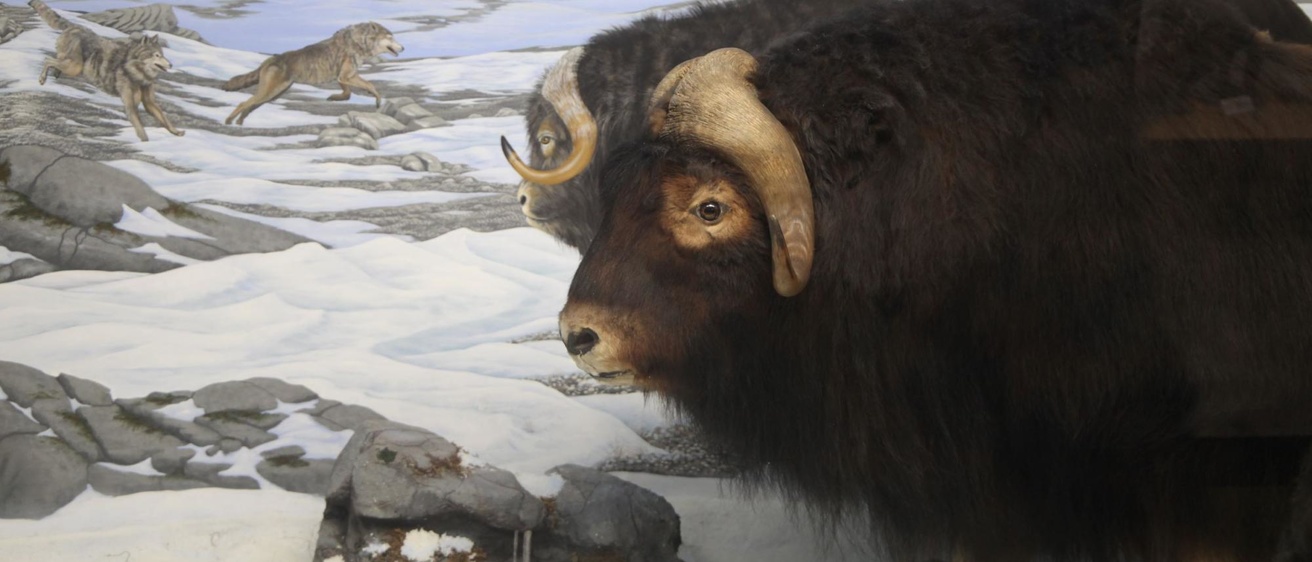Frank Russell's expedition to the Arctic
Twenty-three year old University of Iowa graduate student Frank Russell (1868-1903) embarked on his epic solo journey into northern Canada in August, 1892. He spent over two years traveling alone covering 3,000 miles by train, boat, dog sled and on snow shoes. He returned to Iowa City in October, 1894, receiving a hero's welcome. The trek shattered his health. Russell died 10 years later, at the age of 35, of tuberculosis.
Collecting musk oxen was the primary goal of Russell's expedition. Scientists at the time assumed musk oxen were doomed to extinction. Collecting some of the last specimens for the Museum was thought the responsible thing to do before they disappeared entirely. Russell was also directed to collect whatever other large mammals he could, along with birds, insects, fossils, plants, cultural material and data on the weather.
Every spring and fall the Doug Rib tribes gathered at the edge of the northern barren ground to prepare for the musk oxen hunt. In March 1894 Russell traveled to Ft. Rae, near the Great Slave Lake, and tried to persuade hunters to take him along. He ran into an unexpected obstacle -- the natives believed the animals Russell sent to be mounted in Mollah Edna, the white man's country, would live there happily forever and lure all the other caribou and musk oxen to leave the North and join them. Russell finally persuaded a party of hunters with the promise of food, tea and 1 dollar per day.
The hunters saw a herd on the tenth day of the trip about one mile away. Russell's companions abandoned all pretense of good hunting manners and raced ahead. He was left far behind to struggle with his sled and supplies. By the time Russell arrived on the scene, the natives had slain the animals and claimed them for themselves. He was better prepared when they came upon another herd six days later. Again the natives deserted Russell; however, he had stripped off his bulkiest clothing and emptied his pack of all but bare necessities. This time he managed to keep up with the sprinting natives and shot three musk oxen for himself. Three days later they spotted another large herd. Unfortunately, Russell's sled bogged down in soft snow going up a steep hill. By the time he reached the top, the others were a quarter of a mile ahead and seemingly about to end his last chance to collect the oxen. Russell later confessed in his journal that at that moment he gave up all though of hunting musk oxen and imagined he might just shoot the natives instead. However, at the last moment, a group of four large bulls broke off from the herd and ran in Russell's direction. He managed to kill them all.
It was a difficult journey back. With a 500 pound load of seven musk oxen pelts and skulls, Russell's overloaded and top-heavy sled fell over frequently, sometimes a dozen times for every 100 yards of progress. He did not ride the sled but ran behind it for 400 miles on snowshoes, hanging on tightly so as to stay with the dogs. The party was trapped in a blinding blizzard for the day. The little food they had was given to the dogs. Their fire wood ran out and they had to burn their tent poles to stay warm. When the weather warmed, the ground softened and the Russell's feet got caught in the mud, making every step difficult.
Reference: Russell, Frank. Explorations in the Far North, 1898, University of Iowa.
